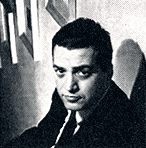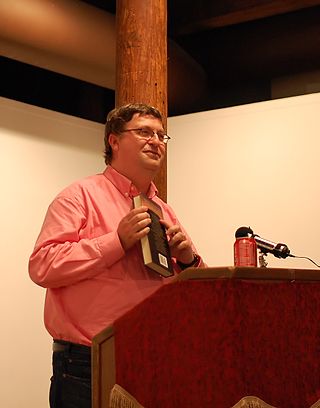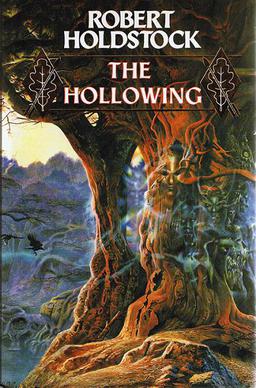
"5,271,009" is a science fiction/fantasy short story by American writer Alfred Bester. First published in The Magazine of Fantasy & Science Fiction , in 1954, it is also known as "The Starcomber". [1]

"5,271,009" is a science fiction/fantasy short story by American writer Alfred Bester. First published in The Magazine of Fantasy & Science Fiction , in 1954, it is also known as "The Starcomber". [1]
To repair the mind of insane artist Jeffrey Halsyon, supernatural being Solon Aquila causes Halsyon to live out various wish fulfillment scenarios — all of which are terribly flawed.
The story was commissioned to fit a pre-existing piece of cover art, wherein a man in a prison uniform (with the serial number 5271009) is shackled to an asteroid. [2]
Bester subsequently explained "5,271,009" as being the number of decisions a man must make in his life; [3] too, the number features in each scenario in some manner.
David Langford has described it as "one of [his] favourite shorts (by Bester)", [1] and Tim Sullivan called it "an extraordinary exploration of solipsism." [4]
Critic and editor Sherryl Vint has posited that the story might be read as "an analogy for [Bester's] relationship to sf", [3] while Fiona Kelleghan has described Aquila as "a sort of fallen angel". [5]

Alfred Bester was an American science fiction author, TV and radio scriptwriter, magazine editor and scripter for comic strips and comic books. He is best remembered for his science fiction, including The Demolished Man, winner of the inaugural Hugo Award in 1953.

Dangerous Visions is a science fiction short story anthology edited by American writer Harlan Ellison and illustrated by Leo and Diane Dillon. It was published in 1967.

Military science fiction is a subgenre of science fiction that depicts the use of science fiction technology, including spaceships and weapons, for military purposes and usually principal characters who are members of a military organization, usually during a war; occurring sometimes in outer space or on a different planet or planets. It exists in a range of media, including literature, comics, film, television and video games.

David Rowland Langford is a British author, editor, and critic, largely active within the science fiction field. He publishes the science fiction fanzine and newsletter Ansible, and holds the all-time record for most Hugo Awards, with a total of 29 wins.

Robert Paul Holdstock was an English novelist and author best known for his works of Celtic, Nordic, Gothic and Pictish fantasy literature, predominantly in the fantasy subgenre of mythic fiction.

Mythago Wood is a fantasy novel by British writer Robert Holdstock, published in the United Kingdom in 1984. Mythago Wood is set in Herefordshire, England, in and around a stand of ancient woodland, known as Ryhope Wood. The story involves the internally estranged members of the Huxley family, particularly Stephen Huxley, and his experiences with the enigmatic forest and its magical inhabitants. The conception began as a short story written for the 1979 Milford Writer's Workshop; a novella of the same name appeared in the September 1981 edition of The Magazine of Fantasy & Science Fiction.

Lavondyss also titled Lavondyss: Journey to an Unknown Region is a fantasy novel by British writer Robert Holdstock, the second book in his Mythago Wood series. Lavondyss was originally published in 1988. The name of the novel hints at the real and mythological locales of Avon, Lyonesse, Avalon and Dis; within the novel Lavondyss is the name of the remote, ice-age heart of Ryhope wood.

Andy Duncan is an American science fiction and fantasy writer whose work frequently deals with Southern U.S. themes.

The Hollowing is a fantasy novel by British writer Robert Holdstock, the third in the Mythago Wood series written. It was originally published in 1993. The title refers to a magical pathway, or hollowing, an archaic English term for a sunken lane or hollow-way. The Hollowing was inspired by the story Sir Gawain and the Green Knight.

The term insectoid denotes any creature or object that shares a similar body or traits with common earth insects and arachnids.

Fiona Kelleghan is an American academic and critic specializing in science fiction and fantasy. She was a metadata librarian and a cataloguer at the University of Miami's Otto G. Richter Library. She left the university in 2011.

Gregory Frost is an American author of science fiction and fantasy, and directs a fiction writing workshop at Swarthmore College in Swarthmore, Pennsylvania. He received his Bachelor's degree from the University of Iowa. A graduate of the Clarion Workshop, he has been invited back as instructor several times, including the first session following its move to the University of California at San Diego in 2007. He is also active in the Interstitial Arts Foundation.
"Time Is the Traitor" is a science fiction short story by American writer Alfred Bester, originally published in The Magazine of Fantasy and Science Fiction in September, 1953. It is included in the Bester collections The Dark Side of the Earth (1964), Star Light, Star Bright (1976) and Virtual Unrealities (1997) and has been extensively anthologized.
A group mind, group ego, mind coalescence, or gestalt intelligence in science fiction is a plot device in which multiple minds, or consciousnesses, are linked into a single, collective consciousness or intelligence. The first alien hive society was depicted in H. G. Wells's The First Men in the Moon (1901) while the use of human hive minds in literature goes back at least as far as David H. Keller's The Human Termites and Olaf Stapledon's science fiction novel Last and First Men (1930), which is the first known use of the term "group mind" in science fiction. The use of the phrase "hive mind", however, was first recorded in 1943 in use in bee keeping and its first known use in sci-fi was James H. Schmitz's Second Night of Summer (1950). A group mind might be formed by any fictional plot device that facilitates brain to brain communication, such as telepathy.

Timothy Robert Sullivan, who more commonly uses the name Tim Sullivan, is an American science fiction novelist, screenwriter, actor, film director and short story writer.
"The Pi Man" is a science fiction short story by American writer Alfred Bester. It was first published in Fantasy and Science Fiction, in 1959. Bester subsequently revised it extensively for his 1976 collection Star Light, Star Bright, changing the characters' names, "develop(ing) minor scenes", modifying the typographical "word pictures", and deleting several "stale references to beatnik culture".

The Best of C. M. Kornbluth is a collection of science fiction and fantasy short stories by American author C. M. Kornbluth, edited by Frederik Pohl. It was first published in hardback by Nelson Doubleday in October 1976 and in paperback by Ballantine Books in January 1977 as a volume in its Classic Library of Science Fiction. A second hardcover edition was issued by Taplinger in November 1977, and an ebook edition by Faded Page in December 2017.
Lorna Diane Toolis was a Canadian librarian. She was head of the Merril Collection of Science Fiction, Speculation, and Fantasy at the Toronto Public Library from 1986 to 2017. She was inducted into the Canadian Science Fiction & Fantasy Association Hall of Fame in 2017.
The Sun has appeared as a setting in fiction since at least classical antiquity.